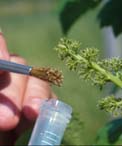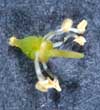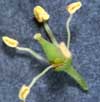
Grape Flowers
Planting Seeds & Making Selections
Grape Breeding Program Information
Authored by: Bruce I. Reisch and Philip Stewart, 2001.

Grape Breeding Procedures
Even without an understanding of grapevine floral biology and genetics, early farmers had the ability to select the best vines and plant new vineyards with vines propagated from their best selections. Today, the science is much more precise, but grapevine breeding is still based on hybridization schemes designed to develop a single elite individual vine combining the best traits of both carefully-chosen parents. Because most grapes are propagated from cuttings, and not grown from seeds, a single vine with good characteristics can be readily turned into many more vines, all with the same genes and thus the same characteristics.
The earliest varieties were propagated from choice wild seedlings, the products of chance crosses between vines. The process of breeding, however, goes one step further, by controlling pollination and choosing which varieties will act as parents for seed production. Parents must be carefully chosen based on the traits desired in the progeny, and what might already be known about a parent's ability to impart those desired traits to its seedlings. The purpose of this web site is to explain the technology of grape hybridization once parental vines have been identified.
|
Male flower |
|
Female flower |
|
Perfect flower |
Basic Background on Grape Flowers
Making crosses is all about flowers. Like many other organisms, grapes reproduce sexually. In other words, each seedling is a unique combination of the genes from a female and the genes from a male. Pollen from a male fertilizes the female ovary, and a seed develops. Depending on the individual vine, flowers might be female, male, or hermaphroditic (also known as "perfect", which means that each flower contains both male and female structures).
By far, the majority of cultivated varieties are hermaphroditic. Because fruit does not result without fertilization, hermaphroditic vines are preferred because they are capable of fertilizing themselves, and every vine planted is capable of bearing fruit.
The male parts of the flower are the stamens, each consisting of a pollen-bearing anther supported by a filament. Generally there are five anthers arranged around the ovary, but some varieties may have more or less. Pollen are shed as the anther ripens and are primarily transported by wind, though rarely more than 20 feet (7 meters) from the source. Pollination occurs when pollen lands on the female parts of a flower. Each pollen grain grows a long tube towards the eggs within the ovary, and sperm cells move down this tube.
The female parts of the flower consist of the ovary, the stigma, and the style. The stigma and style provide the entrance to the ovary for pollen. When a sperm cell in the pollen tube unites with an egg cell in the ovary, an embryo (a new seedling plant) is produced. The embryo grows within the developing seed, while the entire ovary grows to become the grape berry itself with seeds contained within.
A few cultivated varieties, and many wild vines, are female. These plants have flowers which contain a well-formed ovary, stigma, and style, but have poorly formed male parts. The anthers produce pollen that are generally sterile, and the filaments supporting them are often short, and reflexed back away from the ovary. Such varieties require a male or hermaphroditic vine nearby to provide pollen in order to set fruit.
Since male vines are incapable of bearing fruit, they are not used in commercial agriculture, though a few are used as rootstocks. The flowers of these vines contain functional anthers, but the center of the flower has only a small, rudimentary ovary and no stigma or style. These vines reproduce through fertilization of other vines by wind-blown pollen. Many wild vines found throughout North America and Asia are male.
|
"Click"
on each image to see an enlarged version.
|
|
All material Copyright © Bruce I. Reisch, 2001


